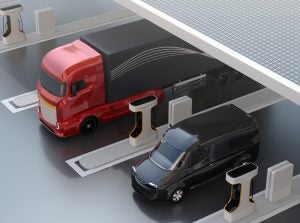Smart charging should be integral part of a national EV charging network
 Electric trucks are coming, and they’re coming fast. Just before 2021 drew to a close, New Jersey, New York and Massachusetts joined California, Oregon and Washington to accelerate the adoption of zero-emission trucks with the adoption of the Advanced Clean Truck program. The U.S. House of Representatives passed the Build Back Better Act and the Infrastructure Investment and Jobs Act, securing up to $67 billion in direct investment in zero-emission trucks and buses, as well as several critical tax credits to support the purchase and production of zero-emission trucks. And more than 150 truck fleets are either operating zero-emission trucks or have trucks on order.
Electric trucks are coming, and they’re coming fast. Just before 2021 drew to a close, New Jersey, New York and Massachusetts joined California, Oregon and Washington to accelerate the adoption of zero-emission trucks with the adoption of the Advanced Clean Truck program. The U.S. House of Representatives passed the Build Back Better Act and the Infrastructure Investment and Jobs Act, securing up to $67 billion in direct investment in zero-emission trucks and buses, as well as several critical tax credits to support the purchase and production of zero-emission trucks. And more than 150 truck fleets are either operating zero-emission trucks or have trucks on order.
However, one key challenge that stands in the way of rapid truck electrification is charging infrastructure. In addition, we must solve for the challenge of integrating all of these vehicles into our grid.
Smart charging should be integral part of a national EV charging network Share on XThe newly formed National EV Charging Initiative — of which Environmental Defense Fund is a founding member — is a coalition of automakers, power providers, electric vehicle and charging industry leaders, labor, and public interest groups working on this exact challenge. The aim is to secure a national charging network that delivers cleaner air and climate action. One of the guiding principles of the initiative states that “electric utilities, regulators, charging providers and stakeholders should work together to accelerate transportation electrification in a way that supports the electric grid and benefits all utility customers.” To achieve this goal, smart charging must be an integral part of the plan.
What is smart charging?
Smart charging — that is, charging at low-cost, beneficial times — can come in a variety of forms.
The most common form of smart charging is managed charging or V1G, which refers to shifting the amount of energy or time of charging to accommodate an external factor, such as price or grid condition. Managed charging can be accomplished by using the flexibility of the battery in the vehicle itself, or by managing the energy consumption of all “behind the meter” assets, such as onsite solar and storage — increasingly common features in truck depot charging.
Alternatively, smart charging can refer to V2G (vehicle to grid) or V2B (vehicle to building) services where these charging assets can provide backup power or resiliency services. Given some vehicle types, such as school buses, are often sitting idle for hours at a time — during which they can be charging or providing energy — it is a missed opportunity to not utilize these resources as a way to benefit customers more broadly.
Some of the benefits of smart charging include:
- Cost savings for fleet owners: Smart charging can help bring down the cost of ownership for fleets transitioning to electric trucks. When fleet owners pay less for electricity to power their vehicles, or are compensated for services, fuel cost savings can be significant, thus improving the value proposition for transitioning more of their fleet to electric.
- A cleaner, more reliable grid: As the power sector transitions to higher levels of intermittent renewable energy, such as solar and wind, load flexibility and storage will be key to ensuring power security and reliability. By leveraging what are essentially batteries on wheels, the cost of storage and potential grid impacts of transitioning to 100% renewable power can be significantly reduced. One study showed that leveraging smart charging for EVs can be one-tenth the cost of similar sized, fixed battery storage.
- Cost savings for all: To accommodate electrification across multiple sectors, some buildout of the grid will be necessary. However, by leveraging solutions like smart charging, the amount of new wires, poles, and distribution centers needed to accommodate this new energy demand can be significantly lowered, and utilization of the existing grid can be maximized, resulting in lower costs to all customers. This can be done by creating incentives to charge during off-peak times, or deploying and managing energy assets to lower on-peak load.
EVs have the potential to revolutionize the grid by supporting a low-cost transition to a carbon-free economy in both the power and transportation sector. Electric utilities, regulators, charging providers and stakeholders should work together to ensure that programs and grants are structured to accelerate transportation electrification in a way that supports the electric grid and benefits all utility customers. With effective coordination of these entities, EVs — in particular, those belonging to the medium and heavy-duty sector — can enable a clean, reliable grid through smart charging.










